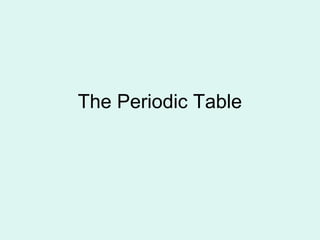The periodic table
- 3. The Table in General ? Columns (families) ĻC Called families ĻC Elements in a family have similar chemical and physical properties ĻC As you go from the top to the bottom of the column the elements get larger.
- 4. This is column 1 the alkali metals Draw an arrow down column one.
- 5. The Table in General ? Rows (periods) ĻC Called periods ĻC First element in a period is a very reactive solid metal ĻC Last element in a family is a very non-reactive gas ĻC Elements get less reactive as you move right ? Reactive means to lose electrons ĻC Elements become less metallic as you move to the right
- 6. This is Period 4 Draw an arrow across period four.
- 8. Alkali Metals ? Shade this column yellow. ? One electron in the valence shell ĻC Valence means the outer shell ? Soft, less dense metals ? Most reactive of all metals ? React with water to form bases ? Never found free, alone, in nature ? Used to make soap, salt, baking soda
- 10. Alkaline Earth Metals ? Shade this column red ? Two electrons in the valance shell ? Harder, higher melting point, more dense than Alkali metals (column 1) ? Very reactive ? Never found free in nature
- 12. Transition Elements ? Shade all these elements purple.
- 13. Transition Elements ? Good conductors of heat and electricity ? Higher melting point than first two families ? Some are hard and brittle ? Some combine with oxygen to form oxides ? Form brightly colored compounds
- 15. Rare Earth Elements ? Shade the elements light blue/teal. ? 1st Row Lanthanide Series ĻC Soft, malleable, great conductors, used to make alloys (mixed metals w/ metals or nonmetals) ? 2nd Row Actinide Series ĻC all but three are synthetic, manmade.
- 16. Boron Family
- 17. Boron Family ? Shade all the elements Green. ? Three electrons in the valance shell ? Collection of "odd ducks" ĻC boron is a metalloid ĻC aluminum, gallium, indium and thallium are poor metals ? Aluminum is the third most abundant element on earth.
- 18. Carbon Family
- 19. Carbon Family ? Shade all elements Dark Blue ? Four valence electrons ? Form organic compounds ĻC Organic means alive or living ? Silicon is the second most abundant element on earth ? Tin resists Oxidation and Corrosion ? Lead is very dense and poisonous
- 20. Nitrogen Family
- 21. Nitrogen Family ? Shade this family Brown. ? Five electrons in the valance shell ? Stable, do not combine easily ? Nitrogen is the most abundant in earths atmosphere. Uses: Fertilizer, dyes, explosives Ex NH3 (Ammonia) ? Phosphorus: Match tips ? Arsenic: Rat Poison
- 22. Oxygen Family
- 23. Oxygen Family ? Shade all elements in this family Orange. ? 6 outer electrons ? Oxygen supports burning, is very reactive, combines with many other elements ? Sulfur, Selenium, Tellurium: Brittle, combine easily with other elements
- 24. Halogen Family
- 25. Halogen Family ? Shade all elements in this family Pink ? Seven valence electrons. ? Most chemically reactive non-metals ? Never found free in nature ? Low melting and boiling point ? As gases they form diatomic elements ex. F2, Cl2
- 26. Noble Gas Family
- 27. Noble Gas Family ? Shade all elements in this family gray. ? Full valance shell, He 2 electrons Ne, Ar, Kr, Xe, Rn all have 8 electrons ? Inert, do not combine with other elements ? He- balloons, Ne- signs, Ar- fill in windows, Xe- photographic lamps, Rn- Treats cancer
- 28. Who has no family?
- 29. Hydrogen (no family) ? Shade this element no color. ? One valance electron ? Highly reactive ? Highly combustible ? Colorless odorless gas at room temperature
- 30. Who has no family?
- 31. Metalloids: Draw the step ladder & Shade the metalloids with stripes.
- 32. Non-metals mark the non-metals with dots.
- 33. Properties of a metal. ? Physical ĻC Superior electric and thermal conductivity ĻC High luster ĻC High density ĻC Malleable ĻC Alkali and Alkaline earth metals are reactive, low density, low hardness, low melting point
- 34. Properties of a metal. ? Chemical ĻC Form positively charges ions ĻC Oxidize easily ĻC React with acid ĻC Some react with water to form a base
- 35. Properties of a non-metal ? Chemical ĻC Form negatively charged ions ? Physical ĻC Brittle when solid ĻC Most are solid and gas (Bromine is a liquid) ĻC Not thermally or electrically conductive ĻC Lower melting points and boiling points than metals
- 36. Definition of a Metalloid ? An element which is like both a metal and a non-metal in terms of malleability, ductility, conductivity and luster
- 37. ? Vertical lines______________________________ ? Horizontal rows____________________________ ? Elements on the zigzag______________________ ? Elements on the top right____________________ ? 1 valance electron reactive family______________ ? 2 valance electron reactive family______________ ? 3-12 families ______________________________ ? Elements that form salts_____________________ ? Elements that do not react___________________ ? Elements that are pulled out from the Periodic table___________________________________ ? Element that is all alone_____________________ Families total of 11 Periods total of 7 Metalloids Non-Metals Alkali Metals Alkaline Earth Metals Transition Elements Halogens Nobel Gas or Inert Gases Rare Earth elements Hydrogen
- 39. Example Element 1. Element: _______________ 2. Symbol: ________________ 3. Atomic mass: _____________ 4. Atomic number:______________ 5. Family: _____________________ 6. Period: ____________ 7. Number of total electrons: _________ 8. Number of valance electrons: _______ Iridium Ir 192.271 77 Transition Element # 9 6 77 2






































